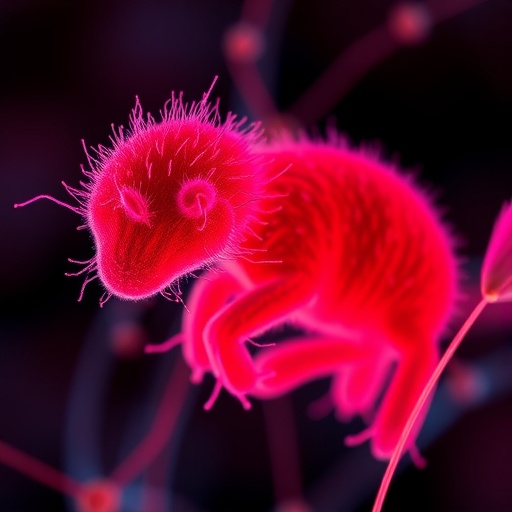In a groundbreaking study that promises to reshape our understanding of neonatal infections, researchers have unveiled how two closely related bacterial species, Ureaplasma parvum and Ureaplasma urealyticum, provoke markedly different inflammatory responses in neonates and human epithelial cell models. This revelation not only deepens the scientific community’s comprehension of neonatal immune reactions but also holds crucial implications for therapeutic strategies aimed at minimizing morbidity in newborns exposed to these pathogens.
Ureaplasma species, which are part of the Mycoplasmataceae family, are unique bacteria lacking a cell wall and known for colonizing the urogenital tract. Despite their small size and minimal genome, these microbes are implicated in a range of perinatal complications such as chorioamnionitis, bronchopulmonary dysplasia, and neonatal sepsis. However, the exact mechanisms by which U. parvum and U. urealyticum incite inflammation have remained elusive until now.
The study employed a multi-dimensional methodology, involving both clinical data from neonates and controlled experiments using human epithelial cell cultures. By juxtaposing inflammatory markers triggered by U. parvum versus U. urealyticum, researchers delineated distinct profiles of immune activation, highlighting specific cytokine expression patterns and signaling pathway engagements unique to each species.
One of the pivotal findings disclosed that U. parvum predominantly induces an inflammatory milieu characterized by elevated levels of interleukin-6 (IL-6) and tumor necrosis factor-alpha (TNF-α), which are key mediators of acute inflammatory responses. This cytokine signature suggests that U. parvum fosters a more aggressive inflammatory environment potentially escalating tissue damage but also mobilizing potent innate immune defenses.
Conversely, U. urealyticum was found to trigger a subtler yet chronic inflammatory state. This pathogen stimulated increased expression of interleukin-10 (IL-10) alongside lower but sustained levels of pro-inflammatory cytokines. IL-10 is an anti-inflammatory cytokine indicative of immune regulatory processes aimed at curbing excessive inflammation. Such a profile insinuates that U. urealyticum might evade immediate immune clearance by modulating host responses, potentially contributing to persistent infections.
In neonatal samples analyzed, these pathogen-specific inflammatory signatures corresponded to distinct clinical presentations. Neonates infected with U. parvum exhibited more acute respiratory distress and systemic inflammatory symptoms, aligning with the pronounced pro-inflammatory cytokine expression. In contrast, those colonized by U. urealyticum often experienced prolonged but less severe inflammatory manifestations, which may contribute to chronic pulmonary complications.
At a cellular level, the dual approach integrating human epithelial cell models lent mechanistic insights into how these bacteria interact with host tissues. U. parvum appeared to activate Toll-like receptor 2 (TLR2) pathways robustly, triggering downstream NF-κB signaling cascades that amplify pro-inflammatory gene transcription. On the other hand, U. urealyticum engaged alternate immune sensors, possibly involving TLR4 and regulatory networks that tilt the balance toward immune suppression.
Furthermore, the implications for neonatal health interventions are profound. Recognizing the species-specific inflammation patterns could pave the way for tailored therapeutic approaches. For example, neonates infected with U. parvum might benefit from targeted anti-inflammatory treatments aiming to reduce acute tissue injury, whereas strategies for U. urealyticum infections might focus on overcoming immune evasion and achieving bacterial clearance without inducing chronic inflammation.
The researchers also emphasized the necessity of refining diagnostic tools to distinguish between U. parvum and U. urealyticum infections rapidly. Current clinical assays often fail to discriminate effectively between these species, potentially leading to generalized treatment regimens that overlook the intricacies uncovered by this study. Enhanced molecular diagnostics, potentially utilizing real-time PCR with species-specific primers, could revolutionize neonatal care in this context.
Additionally, the study sheds light on the broader field of host-microbe interactions during early life, where microbial colonization can dramatically influence immune system development and susceptibility to diseases. The delicate balance between pathogen clearance and immune regulation is especially critical in neonates whose immune systems are immature and vulnerable.
The nuanced understanding of how Ureaplasma species manipulate host immunity also opens avenues for vaccine research. Although no vaccines currently exist against these pathogens, detailed knowledge of their interaction with immune receptors might inform antigen selection and adjuvant formulation to elicit protective responses without exacerbating inflammation.
Moreover, given the increasing interest in the neonatal microbiome, these findings underscore the complexity of microbial communities and their potential dual roles as both commensals and opportunistic pathogens. Differentiating the inflammatory footprints left by closely related species can enhance precision medicine approaches that respect the microbiota’s role in health and disease.
Importantly, the study addresses an urgent public health concern, as infections with Ureaplasma species contribute significantly to neonatal morbidity worldwide, particularly in preterm infants. By dissecting the molecular and immunological distinctions between U. parvum and U. urealyticum, this research equips clinicians and scientists with critical information to refine therapeutic protocols and improve neonatal outcomes.
In summary, this paradigm-shifting work meticulously unravels the differential inflammatory mechanisms elicited by Ureaplasma parvum and Ureaplasma urealyticum, translating complex microbiological interactions into actionable clinical insights. As the scientific community digests these findings, their impact is expected to ripple across neonatology, immunology, and infectious disease research, heralding a new era of species-specific understanding and management of neonatal infections.
Subject of Research: Inflammatory responses in neonates and human epithelial cells induced by Ureaplasma parvum and Ureaplasma urealyticum.
Article Title: Publisher Correction: Ureaplasma parvum and Ureaplasma urealyticum induce distinct types of inflammation in neonates and human epithelial cell models.
Article References:
Zhu, H., Oliveras-Julià, P., Hasperhoven, G.F. et al. Publisher Correction: Ureaplasma parvum and Ureaplasma urealyticum induce distinct types of inflammation in neonates and human epithelial cell models. Pediatr Res (2025). https://doi.org/10.1038/s41390-025-04547-3
Image Credits: AI Generated




